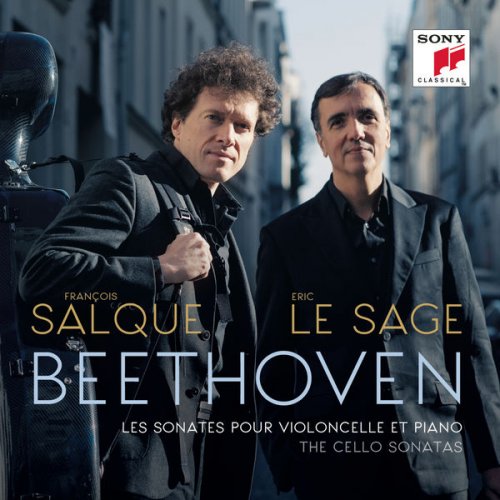François Salque & Eric Le Sage - Beethoven: Sonates pour violoncelle et piano (2017)

Artist: François Salque, Eric Le Sage
Title: Beethoven: Sonates pour violoncelle et piano
Year Of Release: 2017
Label: Sony Classical
Genre: Classical
Quality: flac lossless +Booklet
Total Time: 01:49:17
Total Size: 447 mb
WebSite: Album Preview
TracklistTitle: Beethoven: Sonates pour violoncelle et piano
Year Of Release: 2017
Label: Sony Classical
Genre: Classical
Quality: flac lossless +Booklet
Total Time: 01:49:17
Total Size: 447 mb
WebSite: Album Preview
---------
01. Sonata No. 1 in F Major, Op. 5 No. 1: I. Adagio sostenuto-Allegro
02. Sonata No. 1 in F Major, Op. 5 No. 1: II. Rondo : Allegro vivace
03. Sonata No. 2 in G Minor, Op. 5 No. 2: I. Adagio sostenuto e espressivo-Allegro molto piu tosto presto
04. Sonata No. 2 in G Minor, Op. 5 No. 2: II. Rondo : Allegro. Allegro
05. Sonata No. 3 in A Major, Op. 69: I. Allegro non tanto
06. Sonata No. 3 in A Major, Op. 69: II. Scherzo : Allegro molto
07. Sonata No. 3 in A Major, Op. 69: III. Adagio cantabile-Allegro vivace
08. Sonata No. 4 in C Major, Op. 102 No. 1: I. Andante
09. Sonata No. 4 in C Major, Op. 102 No. 1: II. Adagio-Allegro vivace
10. Sonata No. 5 in D Mjor, Op. 102 No. 2: I. Allegro con brio
11. Sonata No. 5 in D Mjor, Op. 102 No. 2: II. Adagio con moto sentimento d'affecto-attaca
12. Sonata No. 5 in D Mjor, Op. 102 No. 2: III. Allegro fugato
At the beginning of the nineteenth century, Beethoven was one of the first composers to reveal the expressive and technical qualities of the cello, both in his symphonic works and in his chamber music. Some illustrious predecessors (Bach, Geminiani or Vivaldi) had already worked on the creation of an autonomous repertoire of concertos and sonatas for the cello, but Beethoven transformed the former instrument of accompaniment and support of the continuo into a true partner of a music based on dialogue, exchange, and contrast.
Originating from the rebec family that had developed since the twelfth century, the cello appeared as a violin bass in Italy in the seventeenth century, then at the end of the following century its musical role was freed from the accompaniment to which it was most often confined. Until the end of the eighteenth century, its main role was limited essentially to the continuo part, realizing with the harpsichord or organ the bass lines according to the criteria of baroque aesthetics. Some composers (Vivaldi, Boccherini, Bach and Haydn), however, began to give it solo or concerto parts. In the nineteenth century, after Beethoven, many others exploited its virtuosity and specific melodic qualities, especially Schumann, Brahms, Dvorák, Lalo or Saint-Saëns... At the end of the eighteenth century, Haydn was the only one to compose real concertos for cello, but Mozart had already given it some melodic freedom in his last three Strings Quartets commissioned by the King of Prussia Friedrich-Wilhelm II, himself an amateur cellist. It is this same King of Prussia who was the dedicatee in 1796 of the two Sonatas op. 5 "for pianoforte and cello" by Beethoven





![Ben Aylon, Roei Hermon - SMALL ROOM IN DAKAR (2025) [Hi-Res] Ben Aylon, Roei Hermon - SMALL ROOM IN DAKAR (2025) [Hi-Res]](https://www.dibpic.com/uploads/posts/2025-12/1765640683_pl8lfacmwajwc_600.jpg)
![Wadada Leo Smith - Divine Love (1979/2025) [Hi-Res] Wadada Leo Smith - Divine Love (1979/2025) [Hi-Res]](https://www.dibpic.com/uploads/posts/2025-12/1765802240_cover.jpg)

